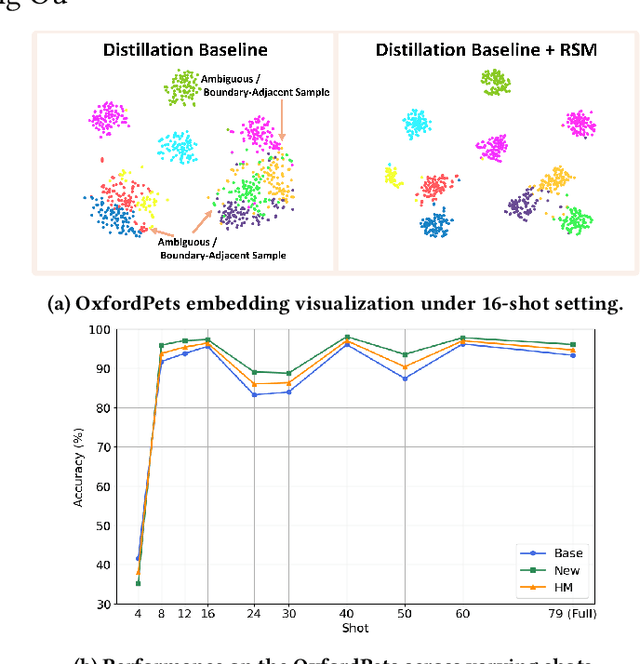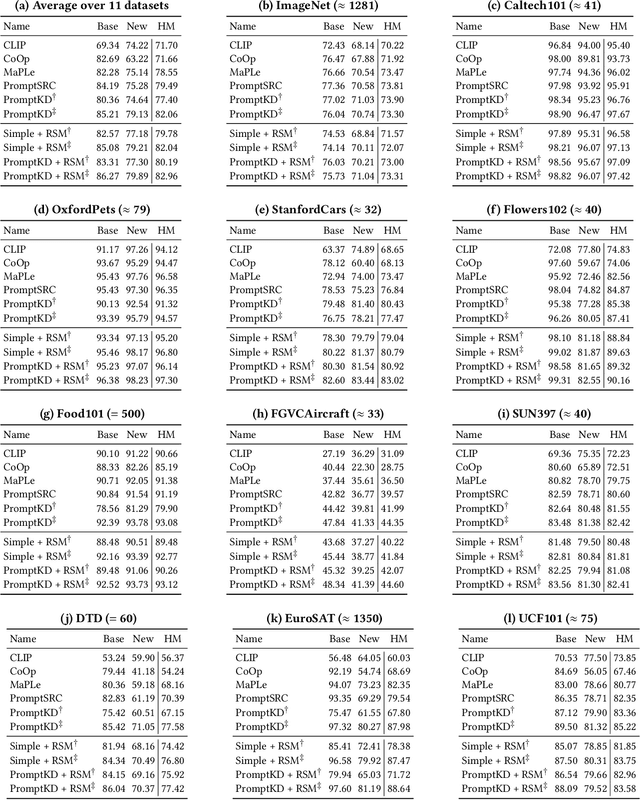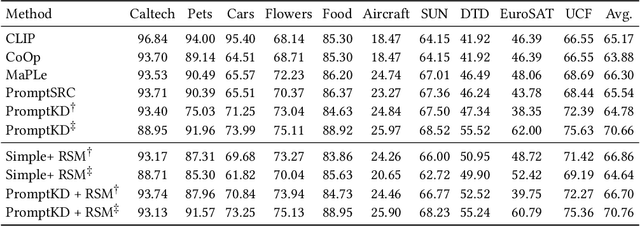Yuming Ou
AME: Aligned Manifold Entropy for Robust Vision-Language Distillation
Aug 12, 2025



Abstract:Knowledge distillation is a long-established technique for knowledge transfer, and has regained attention in the context of the recent emergence of large vision-language models (VLMs). However, vision-language knowledge distillation often requires sufficient training data to achieve robust generalization on amples with ambiguous or boundary-adjacent representations, which are associated with high predictive uncertainty. Critically, collecting such large-scale, task-specific data for training is often impractical in real-world scenarios. To address this major challenge arising from the entanglement of uncertainty and cross-modal feature representation, we propose Aligned Manifold Entropy for Robust Vision-Language Distillation (AME), aiming to achieve robust generalization under real-world conditions. AME applies entropy minimization over a reconfigured shared manifold, where multi-modal data (i.e., image and text) are bridged through a pair of projection functions, conducive to structural compression for cross-modal feature representations. This enables robust knowledge distillation under low-data regimes, while requiring no architectural modifications to the backbone. As a result, it can serve as a plug-and-play module compatible with a wide range of vision-language distillation frameworks. Notably, our theoretical analysis reveals that integrating knowledge distillation with entropy minimization over the shared manifold leads to a tighter generalization error bound. Extensive experiments across diverse distillation architectures and training settings demonstrate that AME consistently facilitates robust knowledge distillation, resulting in superior generalization performance across a wide spectrum of downstream tasks.
IncidentResponseGPT: Generating Traffic Incident Response Plans with Generative Artificial Intelligence
Apr 29, 2024



Abstract:Traffic congestion due to road incidents poses a significant challenge in urban environments, leading to increased pollution, economic losses, and traffic congestion. Efficiently managing these incidents is imperative for mitigating their adverse effects; however, the complexity of urban traffic systems and the variety of potential incidents represent a considerable obstacle. This paper introduces IncidentResponseGPT, an innovative solution designed to assist traffic management authorities by providing rapid, informed, and adaptable traffic incident response plans. By integrating a Generative AI platform with real-time traffic incident reports and operational guidelines, our system aims to streamline the decision-making process in responding to traffic incidents. The research addresses the critical challenges involved in deploying AI in traffic management, including overcoming the complexity of urban traffic networks, ensuring real-time decision-making capabilities, aligning with local laws and regulations, and securing public acceptance for AI-driven systems. Through a combination of text analysis of accident reports, validation of AI recommendations through traffic simulation, and implementation of transparent and validated AI systems, IncidentResponseGPT offers a promising approach to optimizing traffic flow and reducing congestion in the face of traffic incidents. The relevance of this work extends to traffic management authorities, emergency response teams, and municipal bodies, all integral stakeholders in urban traffic control and incident management. By proposing a novel solution to the identified challenges, this research aims to develop a framework that not only facilitates faster resolution of traffic incidents but also minimizes their overall impact on urban traffic systems.
Integrating Large Language Models for Severity Classification in Traffic Incident Management: A Machine Learning Approach
Mar 20, 2024Abstract:This study evaluates the impact of large language models on enhancing machine learning processes for managing traffic incidents. It examines the extent to which features generated by modern language models improve or match the accuracy of predictions when classifying the severity of incidents using accident reports. Multiple comparisons performed between combinations of language models and machine learning algorithms, including Gradient Boosted Decision Trees, Random Forests, and Extreme Gradient Boosting. Our research uses both conventional and language model-derived features from texts and incident reports, and their combinations to perform severity classification. Incorporating features from language models with those directly obtained from incident reports has shown to improve, or at least match, the performance of machine learning techniques in assigning severity levels to incidents, particularly when employing Random Forests and Extreme Gradient Boosting methods. This comparison was quantified using the F1-score over uniformly sampled data sets to obtain balanced severity classes. The primary contribution of this research is in the demonstration of how Large Language Models can be integrated into machine learning workflows for incident management, thereby simplifying feature extraction from unstructured text and enhancing or matching the precision of severity predictions using conventional machine learning pipeline. The engineering application of this research is illustrated through the effective use of these language processing models to refine the modelling process for incident severity classification. This work provides significant insights into the application of language processing capabilities in combination with traditional data for improving machine learning pipelines in the context of classifying incident severity.
 Add to Chrome
Add to Chrome Add to Firefox
Add to Firefox Add to Edge
Add to Edge